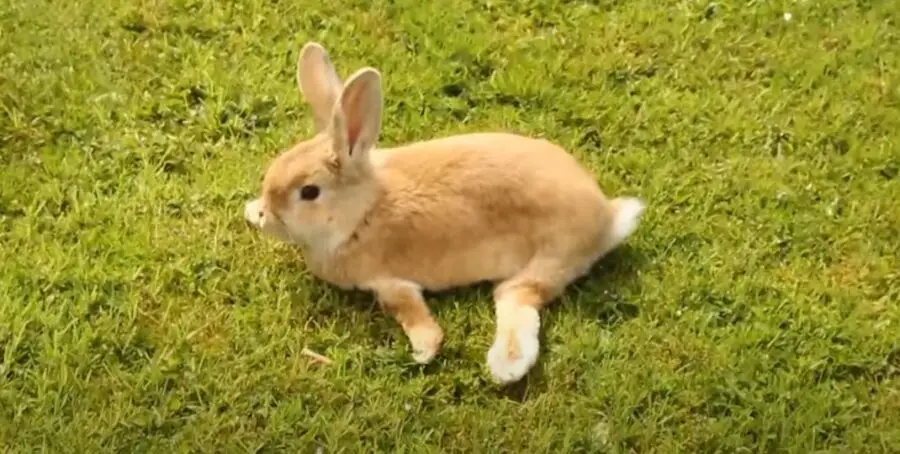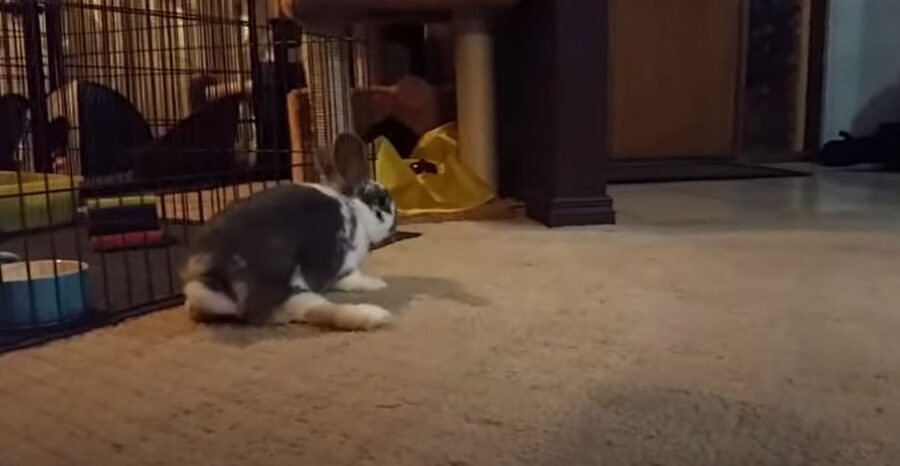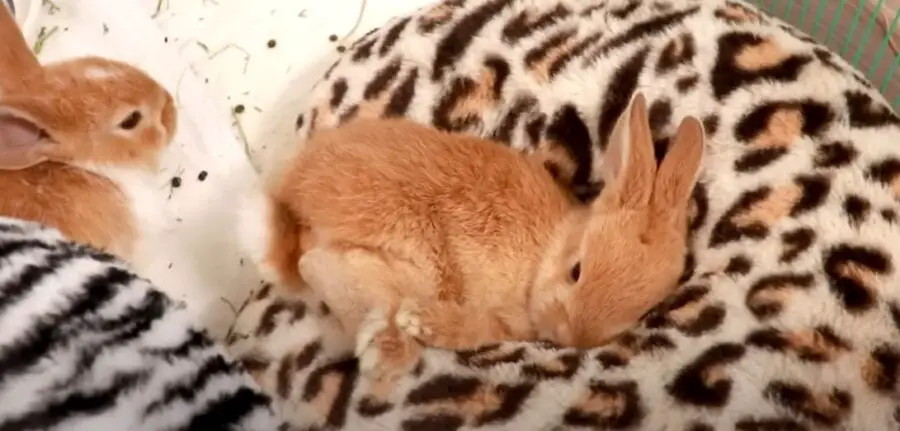It’s truly unfortunate to see splayed legs in rabbits, but we should not be frustrated. Splayed legs in rabbits are not very common, but can be managed. Your rabbit can survive and live a happy life.
What causes splayed legs in rabbits? Can you make a splay leg rabbit brace? Do splayed legs lead to broken legs?
In this article, we will discuss everything we can about splayed legs in rabbits in an effort to help you understand what can be done with the assistance of your rabbit’s vet as well.
Splayed Legs in Rabbits
A rabbit who cannot bring one or more legs under their body has a splayed leg that extends outwards. It’s a physical disability that is inherited in most cases.
One to four legs could be splayed at 45-90 degree angles. The best comparison is how a seal’s flippers look on the side of their body.

Is Splayed Legs Genetic?
Although there is some debate, many experts suggest that splayed legs in rabbits are genetic. Weak connective tissue could be the reason.
The limbs are unable to walk upright or tuck under the body. There is also research indicating that it could be associated with zearalenone toxicity which is an absorption of a potent estrogenic metabolite.
How Do You Treat Splay Leg in Rabbits?
Your rabbit’s vet will help to determine the treatment options for splayed leg depending on the severity of the condition. There are many treatment options such as:
- Surgery
- Splinting
- DIY brace
- Palliative management
- Anti inflammatory medication
- Bandaging
Speak with your trusted vet and take the necessary steps to, at the very least, keep your rabbit comfortable and pain free. A rabbit could survive and live with splayed legs without the urgent need for surgery.
What Causes Splay Leg in Rabbits?
Most likely, splayed legs are inherited genetically from the parents of your rabbit. You may not notice it right away, but a few weeks after birth, it becomes evident that there are one to four legs extending outwards at 45-90 degree angles.
The weakened joints can break down further, causing splayed legs to get worse. In other cases splayed legs could occur from:
- Accident
- Injury
- Trauma
More often than not, it is genetic and inherited. A rabbit with weak joints needs to walk on surfaces that are not slippery or slick. Rugs will help with grip compared to slick laminate flooring which could make splayed legs worse.

What Are The Symptoms of Splay Leg?
A limb sticking outside of the body is the main symptom that is noticeable in splayed legs. You may also witness your rabbit acting:
- lethargic
- flopping
- wiggling
- losing balance
A rabbit with splayed legs will most likely not hop and choose to walk gingerly instead. Unfortunately, there is no outright cure for this condition, but surgery or pain management options will be discussed with your pet’s vet and the next course of action will be yours to decide.
Support Splayed Legs
A rabbit or other mammals with splayed legs need supportive care. Making sure the enclosure is padded and reducing friction against the lower region of the body with multiple surfaces is recommended.
Towels, fabrics, crib liners are all helpful to prevent splayed legs from getting worse. It’s easy for rabbits to get their splayed legs caught in bars or wires.
Can Splayed Leg Fix Itself?
A splayed leg in a rabbit will not fix itself. This is a condition without a cure, but supportive care can help to give your rabbit a better chance at pain free living.
Splayed legs in chicks or birds can be treated in a few days at best with corrective positioning through bone development at early stages in their life.
Splay Leg Rabbit Brace
Bracing a rabbit’s splayed leg could be recommended by your rabbit’s vet. It’s best to brace early in their development.
Bracing is an alternative to amputation and your vet should help you determine this need. In the University of Miami, leg bracing DIY techniques for baby rabbits determined the following successful recommendation that you could try:
- Use a 1 inch cork, cut it to size with cotton pads on each side to act as a brace.
- Move the splayed leg to a normal position, but do not continue if strong resistance by your rabbit is seen. Try again later.
- The cork should be placed between the ankles. Wrapped with physio tape, the legs are held in position.
Your rabbit will try to adjust to this new form of restrictive movement. See if there is improvement or if your rabbit tries to hop around with relative success. You can use this form of physiotherapy frequently to help strengthen or support your rabbit’s splayed leg.
How Much Does It Cost to Fix a Rabbit’s Broken Leg?
A splayed leg is not a broken leg. A rabbit with a fracture will be diagnosed after x-rays. A vet’s expenses could get costly.
On average in the United States, it could cost anywhere from $500-$1500 to treat a broken leg that needs to be set after x-rays are taken.
How Do I Know if My Rabbit Is in Pain?
A rabbit in pain will sit upright or hunched up. They will not choose to move much. The eyes may look half open. A rabbit experiencing mild to moderate pain could show you with teeth grinding.
You may also feel their ears to see if they are getting cold. Rabbits in pain tend not to eat as well. It’s time to visit the vet if you notice these signs.

How Do You Tell if My Rabbit’s Leg Is Broken?
A rabbit with a broken leg will stop hopping. They will limp as well as some the following signs:
- Hunched posture
- Shallow breathing
- Lethargy
- Reluctance to move
- Teeth grinding
Your rabbit needs medical attention at this point. Please schedule a visit with the vet.
Why Does My Rabbit Walk Not Hop?
A rabbit who is not hopping and only walking may not have a broken leg at all. The fact is that bunnies who are not yet adjusted to a new place, may not wish to hop yet.
They may be bashful or fearful during this phase. Show patience, affection and encouragement. Rabbits should hop once comfortable with their surroundings. Stress and anxiety are witnessed in rabbits who are reluctant to hop.
What Is Floppy Bunny Syndrome?
FRS refers to Floppy Rabbit Syndrome. It’s an acute neurological condition where your rabbit doesn’t hop and the muscles are weak or flaccid.
Your rabbit’s vet will diagnose this condition or identify the case as splayed legs if the weakness is localized in the limbs only. This condition needs more research and is often poorly understood.
Why Do Rabbits Struggle When Walking?
A rabbit who struggle when walking could have:
- neurological disease
- splayed legs
- floppy rabbit syndrome
- ear infection
- heart disease
- anxiety
- stress,
- fear
- lack oxygen to the brain
- weak muscle tissue
Rabbits who struggle could be in pain and need a diagnosis of an illness or condition that needs corrective surgery, supportive care or medication. Please visit a vet as soon as you can.

Why Is My Rabbit Falling Over?
Rabbits can fall over when they have poorly developed limbs. In many cases the culprit is an ear infection. When the ears are infected, an imbalance could occur. Notice if your rabbit’s head is tilting.
The infection needs a diagnosis and medication. Otherwise, your rabbit’s vet will check the limbs to see if there are other conditions causing the inability to support themselves properly.
What Happens to Rabbits With Splayed Legs?
A rabbit with splayed legs will often see their limbs stretching further out. It may start at a 45 degree angle and soon become 90 degrees splayed outwards. The joints could wear down and arthritis may develop when there is abnormal pressure placed on the legs.
There are supplements that your rabbit’s vet could recommend for joint support to slow down the wearing of these muscle tissues. Rabbits may develop sore hocks, bald spots, inflammation and other sores.
Rabbits with splayed legs need your help to clear their ears and other grooming. Also make sure they can reach their dishes and water bowls.
Conclusion
Do not feel down if you see that your young bunny has developed a splayed leg. This condition can be supported and your rabbit will live an enriched life with you because of your gentle care.
You will be there for your bunny and your trusted vet will also help with recommendations to make your rabbit feel secure and comfortable in a safe setting within your home.
We thank you for your effort that you are making today to research more about the condition that are witnessing in your rabbit’s limbs and we know that you are doing your best to provide, love, care and support in trying times. There will be sunshine at the end of this tunnel. Keep up the great work.
Thank you for visiting PocketPetCentral.com for the best information to help you enjoy the life of your pocket pet companion in a fun, safe & healthy way.


